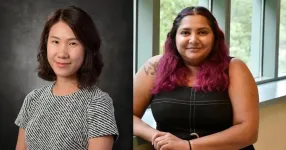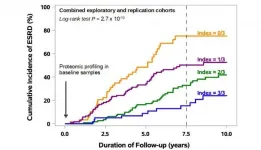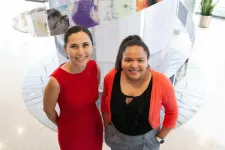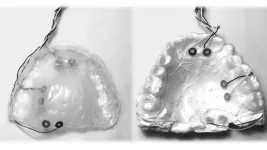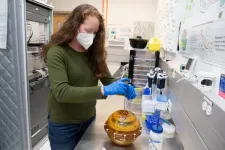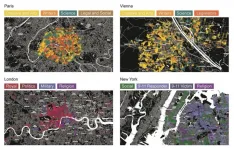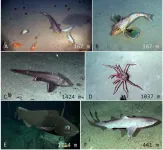(Press-News.org) Directing a meeting, dialing up an old acquaintance, dictating the perfect tuna salad sandwich across a drive-through window. For business and for pleasure, human beings are in constant communication.
Our proclivity for socialization is lifelong, equally prominent in the lives of adolescents and adults. A recent study determined key differences in the ways that various age groups communicate, as well as one conversational component that stands the test of time: friendship. Specifically, bonds between individuals who identify as female.
Led by former Beckman Institute postdoctoral researchers Michelle Rodrigues and Si On Yoon, an interdisciplinary team evaluated how interlocutors' age and familiarity with one another impacts a conversation, reviewing the interaction's overall effectiveness and stress responses generated as a result.
The study, titled "What are friends for? The impact of friendship on communicative efficiency and cortisol response during collaborative problem solving among younger and older women," was published in the Journal of Women and Aging in May 2021.
Two hypotheses form the foundation of this female-focused study. First, the tend-and-befriend hypothesis, which challenges the traditionally masculine "fight-or-flight" dichotomy.
"Women have evolved an alternative mechanism in response to stress," said Rodrigues, who is currently an assistant professor in the Department of Social and Cultural Sciences at Marquette University. "In order to deal with stress, women can befriend female peers."
The team also tested the socio-emotional selectivity hypothesis, which postulates a social "pruning" as humans advance in age and pursue more intimate, higher-quality circles of friends.
The introduction of age as a variable is novel in the field and stems from an interdisciplinary Beckman collaboration.
"I was working with several different groups in several different disciplines, coming from the perspective of studying friendship but having previously done research on adolescent girls, but not older women," Rodrigues said.
She combined forces with then-Beckman-postdoc Si On Yoon, who was studying the cognitive mechanisms of natural conversation across the lifespan, including healthy younger and older adults.
"My research program was focused on language measures in social interactions, and I was glad to work with Dr. Rodrigues to develop an integrative approach including both language processing and physiological measures to study social interactions," said Yoon, who is currently an assistant professor in the Department of Communication Sciences and Disorders at the University of Iowa.
The interdisciplinary team merged both theories into a single query: Across women's lifespans, how are the tendencies to "tend and befriend" as well as socially select reflected in their communication?
They tested a pool of 32 women: 16 "older adults" aged 62-79, and 16 "younger adults" aged 18-25. Each participant was either paired with a friend (a "familiar" conversation partner) or a stranger ("unfamiliar").
The partnerships underwent a series of conversational challenges, wherein the participant instructed her partner to arrange a set of tangrams in an order that only the former could see. The catch? Each shape was abstract, their appearances purposefully difficult to describe.
"You could look at one [tangram] and say, 'This looks like a dog.' Or, you could say, 'This looks like a triangle, with a stop sign, and a bicycle wheel,'" Rodrigues said.
This exercise helped quantify each conversation's efficiency: partners who achieved the desired tangram arrangement in fewer words were considered more efficient, and pairs who needed more words to complete the task were considered less efficient.
The researchers found that while the younger adult pairs communicated more efficiently with familiar partners than their older counterparts, they communicated less efficiently with unfamiliar partners; alternatively, the older adults demonstrated conversational dexterity, quickly articulating the abstract tangrams to friends and strangers alike.
"A referential communication task like this requires that you see where the other person is coming from. It seems like the younger adults are a little more hesitant in trying to do that, whereas the older adults have an easier time doing that with strangers," Rodrigues said.
This was not predicted based on the socio-emotional selectivity hypothesis, which anticipated a correlation between age and social isolation.
"Even though older adults choose to spend more time with people who matter to them, it's clear that they have the social skills to interact with unfamiliar people if and when they choose to," Rodrigues said.
Rodrigues' team also measured salivary cortisol to quantify and compare participants' stress levels throughout the testing process.
"When you experience something stressful, if you have a stress response system that's working as it should, the result is an elevated amount of cortisol, our primary stress hormone, which then tells our bodies to release glucose into our bloodstreams," she said. "That's reflected in our saliva about 15 to 20 minutes after we experience it. If we see a rise in salivary cortisol from an individual's baseline levels, that indicates that they are more stressed than they were at the time of the earlier measurements."
Across both age groups, those working with familiar partners had consistently lower cortisol levels than those working with unfamiliar partners.
"A lot of the research on the tend-and-befriend hypothesis has only focused on young women, so it's great to have these results that pull that out to the end of life. We can see that friendship has that same effect throughout the lifespan. Familiar partners and friendship buffer stress, and that's preserved with age," Rodrigues said.
INFORMATION:
In addition to Rodrigues and Yoon, coauthors include Beckman researchers Kathryn B. H. Clancy, a professor of anthropology at the University of Illinois Urbana-Champaign, and Elizabeth A.L. Stine-Morrow, a professor in the Department of Educational Psychology at the University of Illinois.
Editor's note: The paper associated with this work can be found here: https://www.tandfonline.com/doi/full/10.1080/08952841.2021.1915686
To contact Michelle Rodrigues, email: michelle.rodrigues@marquette.edu
To contact Si On Yoon, email: sion-yoon@uiowa.edu
Elevated levels of three specific circulating proteins are associated with protection against kidney failure in diabetes, according to research from the Joslin Diabetes Center that will be published 30th June in Science Translational Medicine.
"As well as acting as biomarkers for advancing kidney disease risk in diabetes, the proteins may also serve as the basis for future therapies against progression to the most serious types of kidney disease," said Andrzej S. Krolewski MD, PhD, senior author on the publication, senior investigator at Joslin Diabetes Center and professor of medicine ...
A 7- to 15-year longitudinal study of 358 diabetics has linked 3 proteins in blood with a slower progression of diabetic kidney disease and progressive kidney failure. The results from Zaipul Md Dom and colleagues suggest that the proteins could help researchers identify diabetics most at risk of kidney damage, potentially enabling earlier interventions and treatment. Despite advancements in blood sugar control and kidney therapies, patients with type 1 or type 2 diabetes still face a high risk of diabetic kidney disease. This condition can eventually progress to end-stage kidney disease, but some patients show slower kidney decline than others. In recent ...
Despite unprecedented advancements in technology and countless depictions of complex human-AI interactions in sci-fi movies, we have yet to fully achieve AI bots that can engage in conversation as naturally as humans can. Kushal Chawla, researcher at the USC Institute for Creative Technologies (ICT) and a doctoral student in computer science, along with collaborators at both the USC Information Sciences Institute (ISI) and ICT are taking us one step closer to this reality by teaching AI how to negotiate with humans.
The research, presented at the 2021 Annual Conference of ...
Although cardiovascular disease is the main cause of illness among women in the U.S., certain conditions such as coronary microvascular disease (CMD) cannot be easily diagnosed. In a new study, researchers at the University of Illinois Urbana-Champaign have identified specific biomarkers for CMD, which might reduce future hospitalizations.
CMD damages the inner walls of blood vessels causing spasms and decreased blood flow to the heart muscle. "Clinicians look for plaque formation in the blood vessels, which does not occur in CMD," said Zeynep Madak-Erdogan (CGD/EIRH/GSP), an associate professor of nutrition. "Usually, ...
The virus that gives rise to COVID-19 is the third coronavirus to threaten humanity in the past two decades. It also happens to move more efficiently from person to person than either SARS or MERS did. The first African case of COVID-19 was diagnosed in Egypt in mid-February of 2020. Four weeks later, the first lockdowns began across Africa. Steven Schiff, Brush Chair Professor of Engineering at Penn State, who already had established research partnerships in Uganda, saw an opportunity for his team to apply what they were learning from their ongoing efforts to track and control infectious disease and ...
Ten estuaries on the West Coast of North America have been identified as priority locations for expanding the use of conservation aquaculture in a study led by the Native Olympia Oyster Collaborative and funded by the Science for Nature and People Partnership (SNAPP). SNAPP is a research collaboration supported by the National Center for Ecological Analysis & Synthesis (NCEAS) at UC Santa Barbara.
The study, published in Plos One, recommends locations and methods for the strategic expansion of conservation aquaculture to bring back Olympia oyster populations -- both to local estuaries where they have most declined, and into more local restaurants for oyster lovers to dine on. The authors propose using aquaculture in these estuaries -- ...
Even the mundane act of swallowing requires a well-coordinated dance of more than 30 muscles of the mouth. The loss of function of even one of these, due to disease or injury, can be extremely debilitating. For these people, nerve stimulation offers a ray of hope to regain some of their lost oral function.
In a new study, researchers at Texas A&M University have delineated the minimum size of electrical currents needed to provide sensation in different parts of the mouth. The researchers said their study is a first but vital step toward building electrical stimulation implants that can restore essential intraoral functions that are lost due to nerve or brain damage.
The results of the study are published in the journal ...
Magnetic resonance imaging (MRI) is widely used in medicine to detect, diagnose and treat diseases such as cancer, while relying on experts' interpretation of images. Quantitative MRI, which obtains numerical measurements during the scans, can now potentially offer greater accuracy, repeatability and speed -- but rigorous quality control is needed for it to reach its full potential, according to a new study.
Researchers at the National Institute of Standards and Technology (NIST) led the study by 11 institutions comparing measurements by 27 MRI scanners from three vendors at nine clinical sites around the country. To obtain reference values and disentangle sources of bias and variation, the study used a tissue stand-in, or "phantom," originally ...
A city's street names can provide a glimpse into its cultural value system and a way to quantify cultural indicators, according to a study published June 30, 2021 in the open-access journal PLOS ONE by Melanie Bancilhon from Washington University in Saint Louis, U.S., and colleagues.
Ever since named streets have existed, they have been used as a form of social engineering, mirroring a town or city's social, cultural, political, and religious values. Building off this concept in what they term "streetonomics," Bancilhon and colleagues used street names as an alternative route to quantify cultural indicators in four influential Western cities: Paris, Vienna, London, and New York.
The authors used multiple open data sources ...
The deep sea Pacific Salas y Gómez and Nazca ridges are highly biodiverse and host unique fish and invertebrate taxa, according to video surveys.
INFORMATION:
Article Title: Deep-sea biodiversity at the extremes of the Salas y Gómez and Nazca ridges with implications for conservation
Funding: The expeditions were funded by the National Geographic Society and Pristine Seas donors with support to AMF. Conservation International, the Paul M. Angell Family Foundation, Tom and Currie Barron, and Alan Eustace provided additional support to DW, WG and JG. The Chilean Millennium Science Initiative Program grant #NC120030 ...
